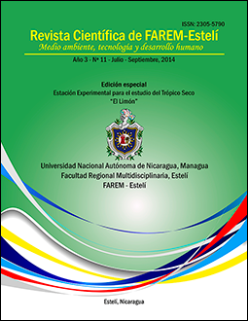Efectos post – incendio en bosques de pino del trópico seco de Nicaragua
DOI:
https://doi.org/10.5377/farem.v0i11.1608Palabras clave:
Intensidades de incendio, riqueza de especies, cobertura, estratos de la vegetaciónResumen
La investigación se realizó en la Reserva Natural Serranías de Dipilto y Jalapa. Con el objetivo de evaluar los efectos post-incendio en la riqueza y cobertura de herbáceas y leñosas, en bosque de pino.
Se determinaron tres intensidades de incendio: alta, media, baja y un control (área no incendiada); mediante la cicatriz dejada por el fuego en los fustes de los árboles de pino. Se establecieron parcelas circulares de 314.16 m2, donde se cuantificó la riqueza y cobertura de especies en tres estratos de la vegetación: arbóreo, arbustivo y herbáceo.
En la alta intensidad se encontraron 22 especies en total. Mientras que en la media y baja intensidad se registraron de 18 especies. En el área no incendiada, se encontraron 12 especies. Es evidente que la mayor riqueza de especies se observó en la alta intensidad, lo cual se debe a la activación de los mecanismos de rebrote y bancos de semilla.
El aumento de la cobertura de especies herbáceas y leñosas es directamente proporcional a las intensidades del incendio, la cual está vinculada a la riqueza de especies.
DOI: http://dx.doi.org/10.5377/farem.v0i11.1608
Revista Científica de FAREM-Estelí No.11 2014: 91-101
Descargas
1025
Descargas
Publicado
Cómo citar
Número
Sección
Licencia
© Revista Científica de FAREM-Estelí

